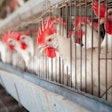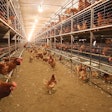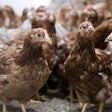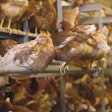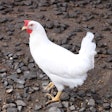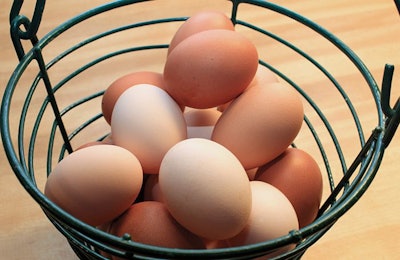
Egg size is closely linked with hen age – the older the hen the bigger the egg, but there are numerous other influencing factors. Every management aspect in egg production can impact the size of an egg, with body weight and nutrition having the greatest influence.
Body weight
Some birds have a genetic predisposition to grow more than others, linked to feed intake, and this eventually influences egg size. Because of this, producers must fully consider the breed that they rear. Brown layers, for example, are heavier than white hens, so they will produce bigger eggs.
Body weight is an important parameter of success during egg production, especially during the rearing period. It provides indicators of when to switch feeds according to physiological requirements and skeletal formation.
A layer’s body weight can also provide an indication of egg size during the entire production period. An established rule of thumb is that, for each 100 grams of reduction in body weight, egg size will reduce by 0.8 to 1.0 gram.
Body weight at the onset of egg production regulates egg weight during the whole laying cycle, and heavier hens lay heavier eggs.
Light stimulation is a key tool to promote sexual maturity and egg size. A slow step-down program during the rearing period gives the pullet more light hours to eat and grow, delays maturity and leads to a larger egg size. A faster step-down lighting program provides fewer light hours and slower growth, but promotes earlier sexual maturity and a smaller egg size.
To determine the onset of egg production, both the age at which light stimulation occurs and body weight need to be considered as they play an important role in the maturity of the reproductive organs. As hens age, they lay larger eggs, and egg size is usually inversely proportional to the number of eggs laid. The faster the onset of production, the greater the total of eggs at the end of the laying cycle.

Every aspect of layer management can impact egg size, but body weight and nutrition will have the greatest influence. (Courtesy Evonik)
Nutrition
Layers face a period of heat stress due to the impact of feed intake and eventually reaching desired egg size.
Any issue that modifies feed intake affects egg weight. For example, in a cooler environment or in non-cage production systems, energy requirement is increased, and birds compensate by eating more. The tangible implication of feed intake is nutrient intake, especially protein (amino acids) which has a greater influence on egg size than energy intake.
As the layer ages, eggshell quality decreases due to lower calcium absorption and larger egg size. Eggshell weight is relatively constant over a hen’s age, so distributing a constant amount of shell over a larger egg results in increased egg losses, due to weaker eggshell at late phase lay.
To some extent, decreasing dietary crude protein, balanced through essential amino acids according to the ideal protein profile, is a good tool to prevent “extra-large” or “jumbo” eggs during the latter part of the production cycle. The layer’s requirement decreases due to a natural drop in egg production. Extra crude protein in the diet when egg mass decreases as the hen’s age increases, fosters body and egg weight growth.
Do not alter methionine
Based on most of the amino acid studies in layers, the egg weight parameter is more sensitive to dietary amino acids than the number of eggs produced.
Hens reach maximal rate of lay at much lower amino acid intake levels than they do at maximal egg mass. Layers need a much higher methionine + cysteine and lysine intake level to achieve maximal egg weight, while threonine and tryptophan have no significant effect compared to maximal rate of lay. On the other hand, threonine and tryptophan result in stronger response to rate of lay versus lysine and methionine + cysteine, which have moderate effect.
Methionine is the first limiting amino acid in layers, and reducing it will not only reduce egg size, but production will shrink as well. Therefore, altering methionine supplemental inclusion levels or the recommendation level is highly risky, especially when diets are formulated applying the ideal protein profile.
Ratios must be permanently maintained, otherwise the balancing protein concept would be dislodged. Therefore, it is recommended when working with ideal protein profile to adjust lysine levels maintaining ideal amino acid ratios.Simply reduce crude protein level in the layer diet, studies shown that a daily additional gram of protein intake increases average egg weight by 1.4 g.

Body weight at the onset of egg production regulates egg weight during the whole laying cycle, and heavier hens lay heavier eggs.






